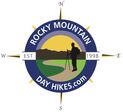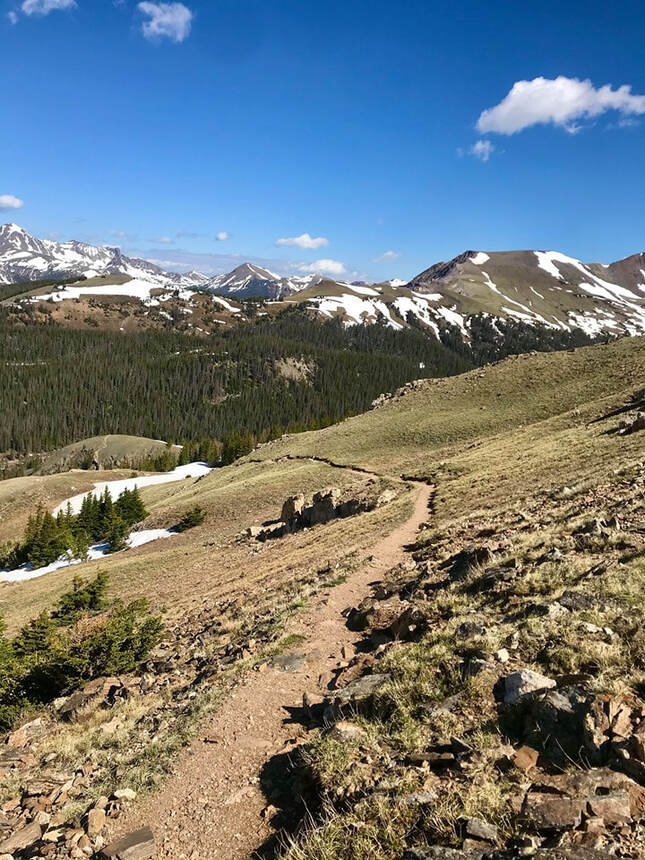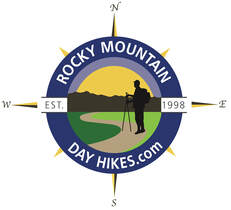|
Notes from the
Trail |
|
Story by Barb Boyer Buck Photos by Simon Vogt “The summit is the goal, but it’s not the reason.” For Simon Vogt, mountaineering in the high peaks of Colorado’s Rocky Mountains has become a metaphor for the new life he is developing for himself: one of sobriety and focus. Simon has attempted to climb Longs Peak twice – once in November of last year and then again in April of this year. The most recent trek to Longs ended at the intersection of trails leading to Chasm Lake and Boulder Field. “I knew that I was being very ambitious trying to climb Longs at that time,” he explained. “It was winter time, I was alone, and I hadn’t done anything that big in terms of altitude and class. “I set out, all prepared and with every intention to summit. I didn’t get very far, only 4-5 miles in, when I reevaluated the time it took me to get there, the time I still had ahead of me, the weather, and the time of day. I decided I’d gone far enough & turned around there.” This thoughtful attitude hasn’t been Simon’s strategy his entire life, however. He was born and lived in Germany for eight years after which his family moved to New York. He moved to Colorado for college in the early-1990s. “Colorado is the first place I developed a real interaction with the outdoor world – climbing, hiking & mountain biking,” he said. But he also encountered tumultuous problems with the law, alcohol and drugs. His naturally impulsive and reckless nature got him into some real trouble while he was using and drinking. “I almost died many times,” he said citing a week-long coma from a heroin overdose in 1994 and daring mishaps while bouldering with friends. “I was also shot at several times and stabbed as a result of poor choices,” he said. “It was the world I was living in at the time.” Simon moved back to Colorado about four years ago and a couple of years after that, he almost died again. “I quit drinking after I went to the emergency room for pancreatitis. That felt very deathbed-like,” he said. This was a little more than 18 months ago, in September, 2018. “Being able to get up from that bed and walk out of the hospital was the beginning of a new start, and a miracle.” He faced an immediate test right after getting sober: his boss died, he got evicted from his apartment, and his girlfriend left him. He started living in his truck. In these uncertain days, Simon started taking walks at night because he couldn’t sleep. “I got back into hiking more and more after that,” he said. In the past year, Simon has climbed 17 of Colorado’s 14ers and many other slightly-lower summits. His favorite summit in Rocky Mountain National Park (so far) is Mount Ida, about a 9-mile roundtrip trek that begins at Milner Pass, off Trail Ridge Road. On June 7, he got to the trailhead about 7:30 a.m. and immediately encountered a snow-covered trail. “I put on my nanospikes but right away I got lost,” he said. “It probably took me about two hours to get to treeline, (twice the time it usually takes).” Once he got to the tundra, the trail runs along the Continental Divide. “It was a perfect day, sunny and sometimes partly cloudy. After treeline the trail is dry and well-tread, you can see the path stretch out for about a mile at a time. It’s really gentle and travels up to 12,000 feet,” he explained. From this path, Simon could see features from both sides of the Divide including Rock Cut, Trail Ridge Road, the Alpine Visitor’s Center, the Never Summer Range, Lake Granby, and Longs Peak. I summited at noon and the first time I saw anyone else was on the way back down, about a mile from the summit. It’s nice to be alone, but running into someone is reassuring. It’s a secret link between you and them, a comradery of being with someone within a 10 miles radius. “ Simon generally hikes alone, especially on his longer adventures. “Mountaineering is very peaceful, meditative, and an inner experience,” he said. “There’s a dichotomy between being deep inside of yourself, examining your consciousness from a little further back in your mind, juxtaposed with the physical challenges of the outside environment. “Emotionally it puts me very much at ease, I go out there for the feeling of solitude, to get more of an inner connection by having that outward experience. This is when I thrive and feel alive.” On these treks, Simon also finds he can communicate quite easily with what he understands as God; this has been one of his touchstones since achieving sobriety. “Turning your life over to a higher power, trusting that things are going to be OK, any way it turns out-- that is the key,” he said. “You have to let things go and not stress or be anxious about things you don’t have any control over, like trail conditions or the weather, or what you encounter at work.” “Once you see yourself as connected to a greater path in life it’s easier to enjoy the moment.” The gratitude he feels while on these trips reinforces this connection. Suddenly, he is no longer the outcast and trying to fit himself into a shape society asks him to fill. These days, Simon works as a freelance contractor and carves out considerable time for traveling and mountaineering. While standing on these mountaintops alone, he sees these moments as wonderful gifts– that are uniquely for him alone. “I experience a rush of endorphins, that weird chemical euphoria that I used to seek out artificially,” he explained. “I become grateful for being a human on this planet, for having legs to get me to the summit.” Simon is continuously honing his preparation for hiking, after every trip he has figured out a way to lighten his pack a bit more and reduce the amount of water he carries. His advice for hiking is similar to his advice for achieving and maintain sobriety. “When climbing a mountain, you should only expend about ¾ of your energy climbing to the summit, you need to reserve about ¼ for the return,” he counseled. “You need to find your own path and whatever path that is, keep moving. Keep moving even if it’s not forward, sometimes you have to go sideways. As long as you keep going – take another step and then another and another. “I apply the same things in hiking that I apply in recovery; it’s not necessarily getting to the mountain top that’s the important thing. In life, you’re never like ‘I made it!’ You never truly reach that point. You’re never done, it’s never over. Once you get to the top you have to get back down.” Taking responsibility for his actions, along with expecting setbacks on the journey is essential to Simon’s new outlook on life. “If you can use those setbacks and disappointments not as a discouragement but as a motivator, you succeed,” he said. “They are learning experiences and that’s what it takes to improve. You have to expect to have problems and run into unforeseen things – in life and in hiking.”
0 Comments
Leave a Reply. |
"The wild requires that we learn the terrain, nod to all the plants and animals and birds, ford the streams and cross the ridges, and tell a good story when we get back home." ~ Gary Snyder
Categories
All
“Hiking -I don’t like either the word or the thing. People ought to saunter in the mountains - not hike! Do you know the origin of the word ‘saunter?’ It’s a beautiful word. Away back in the Middle Ages people used to go on pilgrimages to the Holy Land, and when people in the villages through which they passed asked where they were going, they would reply, A la sainte terre,’ ‘To the Holy Land.’ And so they became known as sainte-terre-ers or saunterers. Now these mountains are our Holy Land, and we ought to saunter through them reverently, not ‘hike’ through them.” ~ John Muir |
© Copyright 2025 Barefoot Publications, All Rights Reserved












